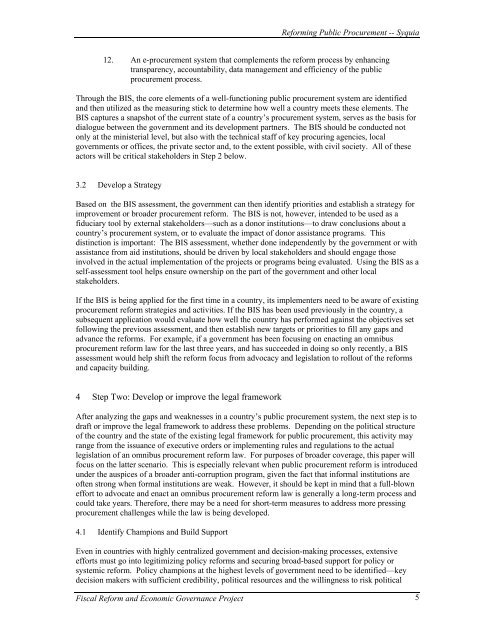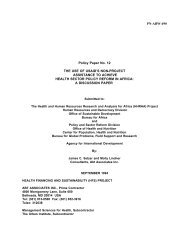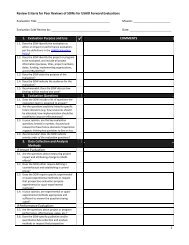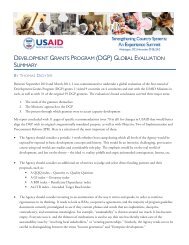Reforming Public Procurement in Emerging Market ... - KDID Portal
Reforming Public Procurement in Emerging Market ... - KDID Portal
Reforming Public Procurement in Emerging Market ... - KDID Portal
Create successful ePaper yourself
Turn your PDF publications into a flip-book with our unique Google optimized e-Paper software.
<strong>Reform<strong>in</strong>g</strong> <strong>Public</strong> <strong>Procurement</strong> -- Syquia<br />
12. An e-procurement system that complements the reform process by enhanc<strong>in</strong>g<br />
transparency, accountability, data management and efficiency of the public<br />
procurement process.<br />
Through the BIS, the core elements of a well-function<strong>in</strong>g public procurement system are identified<br />
and then utilized as the measur<strong>in</strong>g stick to determ<strong>in</strong>e how well a country meets these elements. The<br />
BIS captures a snapshot of the current state of a country’s procurement system, serves as the basis for<br />
dialogue between the government and its development partners. The BIS should be conducted not<br />
only at the m<strong>in</strong>isterial level, but also with the technical staff of key procur<strong>in</strong>g agencies, local<br />
governments or offices, the private sector and, to the extent possible, with civil society. All of these<br />
actors will be critical stakeholders <strong>in</strong> Step 2 below.<br />
3.2 Develop a Strategy<br />
Based on the BIS assessment, the government can then identify priorities and establish a strategy for<br />
improvement or broader procurement reform. The BIS is not, however, <strong>in</strong>tended to be used as a<br />
fiduciary tool by external stakeholders—such as a donor <strong>in</strong>stitutions—to draw conclusions about a<br />
country’s procurement system, or to evaluate the impact of donor assistance programs. This<br />
dist<strong>in</strong>ction is important: The BIS assessment, whether done <strong>in</strong>dependently by the government or with<br />
assistance from aid <strong>in</strong>stitutions, should be driven by local stakeholders and should engage those<br />
<strong>in</strong>volved <strong>in</strong> the actual implementation of the projects or programs be<strong>in</strong>g evaluated. Us<strong>in</strong>g the BIS as a<br />
self-assessment tool helps ensure ownership on the part of the government and other local<br />
stakeholders.<br />
If the BIS is be<strong>in</strong>g applied for the first time <strong>in</strong> a country, its implementers need to be aware of exist<strong>in</strong>g<br />
procurement reform strategies and activities. If the BIS has been used previously <strong>in</strong> the country, a<br />
subsequent application would evaluate how well the country has performed aga<strong>in</strong>st the objectives set<br />
follow<strong>in</strong>g the previous assessment, and then establish new targets or priorities to fill any gaps and<br />
advance the reforms. For example, if a government has been focus<strong>in</strong>g on enact<strong>in</strong>g an omnibus<br />
procurement reform law for the last three years, and has succeeded <strong>in</strong> do<strong>in</strong>g so only recently, a BIS<br />
assessment would help shift the reform focus from advocacy and legislation to rollout of the reforms<br />
and capacity build<strong>in</strong>g.<br />
4 Step Two: Develop or improve the legal framework<br />
After analyz<strong>in</strong>g the gaps and weaknesses <strong>in</strong> a country’s public procurement system, the next step is to<br />
draft or improve the legal framework to address these problems. Depend<strong>in</strong>g on the political structure<br />
of the country and the state of the exist<strong>in</strong>g legal framework for public procurement, this activity may<br />
range from the issuance of executive orders or implement<strong>in</strong>g rules and regulations to the actual<br />
legislation of an omnibus procurement reform law. For purposes of broader coverage, this paper will<br />
focus on the latter scenario. This is especially relevant when public procurement reform is <strong>in</strong>troduced<br />
under the auspices of a broader anti-corruption program, given the fact that <strong>in</strong>formal <strong>in</strong>stitutions are<br />
often strong when formal <strong>in</strong>stitutions are weak. However, it should be kept <strong>in</strong> m<strong>in</strong>d that a full-blown<br />
effort to advocate and enact an omnibus procurement reform law is generally a long-term process and<br />
could take years. Therefore, there may be a need for short-term measures to address more press<strong>in</strong>g<br />
procurement challenges while the law is be<strong>in</strong>g developed.<br />
4.1 Identify Champions and Build Support<br />
Even <strong>in</strong> countries with highly centralized government and decision-mak<strong>in</strong>g processes, extensive<br />
efforts must go <strong>in</strong>to legitimiz<strong>in</strong>g policy reforms and secur<strong>in</strong>g broad-based support for policy or<br />
systemic reform. Policy champions at the highest levels of government need to be identified—key<br />
decision makers with sufficient credibility, political resources and the will<strong>in</strong>gness to risk political<br />
Fiscal Reform and Economic Governance Project 5







